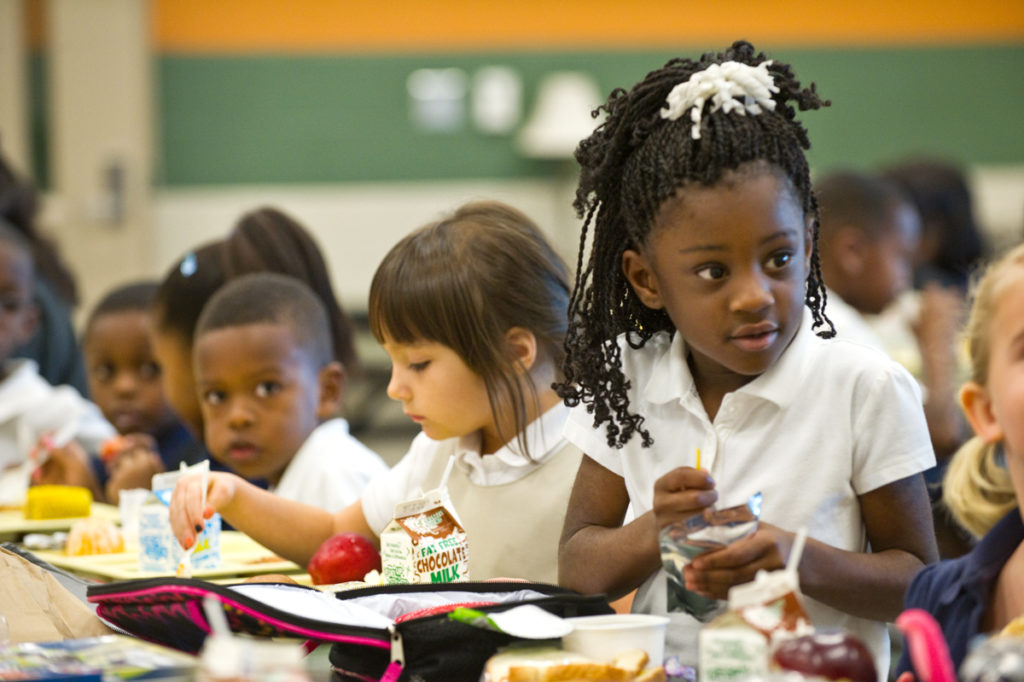

To truly change the dynamics of the lunchroom environment, schools must address the issues through a schoolwide effort involving all staff and an examination of the overall structures of the lunchroom. I highly recommend the educational and social value of “reforming” the lunchroom. Many schools involved in implementing Responsive Classroom practices schoolwide have taken this pivotal step, and the positive effects are powerful.
My intention here is to suggest some strategies that the individual teacher can use regardless of the overall structure of lunch. These are steps that one teacher can take to make lunch a more positive experience. Certainly, strategies could be used as well by all teachers in a schoolwide lunchroom reform.
In order for children to successfully meet behavior expectations and willingly work for a more positive lunchtime, teachers must first lay a foundation for meaningful purpose.
You can prepare children for success by discussing with your students the purpose of lunchtime. With this as a reference point of meaning, children can see the connection between their behavior and what they hope to achieve at lunch. Some questions to ask are: How will we take care of ourselves and each other so that we enjoy our lunch and our friends? How does the cafeteria rule “Stay in your seats” help us to do this?
Through discussing such questions, children clearly understand the meaning behind the rules and structures of lunch and the expectations for their behavior. Ultimately these discussions lead to the final step of naming, modeling, role playing, and practicing the specific behaviors that will prepare children for success.
You can begin the practice of “doing lunch” in your classroom. For example, after a discussion about what you might say and do to be successful in the lunchroom, you can model lunchtime behaviors for your students. The children identify your actions, your words, possibly your thoughts and feelings, and your affect.
Next, a few children model how they will act at lunch while the others notice their positive behaviors. Finally, you practice lunch as if you were all in the lunchroom. Continue this process until you have modeled and practiced all the important segments of lunchtime behavior from getting ready to go to lunch to returning from the cafeteria. Now, you can move to practicing in the cafeteria itself, not during lunch periods but at another time of the day. Whenever possible, enlist the help of the cafeteria workers as well.
When you set up structures and events that keep the quality of fun and enjoyment in lunchtime, children are better able to see a purpose to working cooperatively and managing some of the more challenging expectations. Here are some ideas from teachers who use the Responsive Classroom approach.
The structure of “lunch partners” can have many positive effects on what happens during lunchtime. It eliminates a great deal of anxiety and competition around the issue of who sits next to whom and it gives children an opportunity to get to know all of their classmates.
Some structures and routines that have worked for lunch partners:
This is a positive way to build children’s capacity and interest in having productive and socially skilled conversations with one another. Begin by exploring why we talk with friends and classmates and what makes a conversation or talk between people interesting and worthwhile.
From this discussion the class should be able to create a list of possible ingredients that would make a successful conversation. The children then can refer to this list as they practice and evaluate their skill of conversing.
With these ingredients in mind, the class can brainstorm a list of topics that might be interesting, worthwhile, and/or fun for them to use as topics for talking during their lunchtimes. Some examples of topics: things to do on an overnight at a friend’s house, favorite desserts, what makes a hero, favorite activities in the summer/winter . . .
Here is a sampling of activities that can be done with these topics:
A simple but powerful strategy is to teach children some fun and appropriate games that can be used while waiting for lunch to be done. Again and again, we see children losing their self-control because of overly long “wait times.”
Brainstorm a list, make sure everyone knows how to play, post the list, and then each day before leaving the classroom remind children to pick a game that they will use if necessary. Many of the activities that are used in Morning Meeting or on car trips are excellent for children to use in the cafeteria (Aunt Minerva, 20 Questions, Guess the Number, I See Something . . .).
You can begin each afternoon with an “after-lunch” meeting in which you reflect on the events of lunch and celebrate success. You might choose one behavior each day and have children share how they’re doing and what new strategies they’ve learned to be even more successful! Sharing compliments with each other about the specific ways they’ve noticed each other “being successful” is another way to build in a positive focus to the reflection. After sharing the successes, you can also use this meeting to do some problem-solving if some behaviors weren’t successful.
Preparing the children in your classroom for a peaceful and successful lunchtime is possible and can bring powerful results for your class. As you help your children to be successful at lunch, others will begin to notice that success. The first steps to reforming lunchtime practices and procedures lie with the individual teachers.
With a growing awareness among teachers, a school can begin to explore and address more broadly the overall cafeteria environment: use of space and furniture; the scheduling and class mixes; the routines and discipline; the supervision and signals; and the structures to build and practice social skills that will create a peaceful and enjoyable lunchtime experience for the entire school community.
From the Responsive Classroom Newsletter: February 1997.